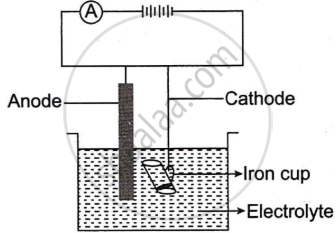Advertisements
Advertisements
प्रश्न
4 tones of bauxite, 150 Kg of sodium hydroxide and 600 Kg of graphite.
The aluminium compound in bauxite is aluminium oxide and the main impurity is iron (II) oxide. Aluminium is obtained by the electrolysis of aluminium oxide dissolved in cryolite.
(a) When bauxite is treated with sodium hydroxide solution, what happens to:
(i) the aluminium oxide?
(ii) The iron (III) oxide?
उत्तर
(i) Aluminium oxide being an amphoteric oxide reacts with sodium hydroxide solution to form soluble sodium meta aluminate.
\[\ce{\underset{\text{Alumina}}{Al2O3.2H2O} + 2NaOH + 2H2O ->\underset{\text{Sodium aluminate}}{2NaAIO2} + 3H2O}\]
(ii) Iron (III) oxide remains undissolved in the sodium hydroxide solution and settles down.
APPEARS IN
संबंधित प्रश्न
Name the following:
A metal oxide that can be reduced by hydrogen.
How is the following metallic oxide reduced? Write equations:
Iron (ll) oxide
Give reason for the following:
Carbon anodes are used in the electrolytic extraction of aluminium.
Name oxide of one metal which is reduced by (give equation): Electrolytic reduction
For the reaction of a metal oxide. Suggest a reducing agent other than carbon
Name a non-metallic element which is a liquid at ordinary temperatures
What metallic property is shown by the non-metal graphite?
Answer the following question :
Name the process used for the enrichment of sulphide ore.
Name the following :
A metal oxide that can be reduced by hydrogen
The following sketch represents the electroplating of an Iron cup with Nickel metal.
Study the diagram and answer the following questions:

- During electroplating, the iron cup is placed at the cathode. Why?
- Name the ion that must be present in the electrolyte.
- State one condition that is necessary to ensure that the deposit is smooth, firm and even.
- Write the reaction taking place at the cathode.
- What change would you observe at the anode?
